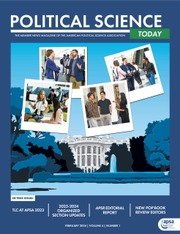Despite significant progress over the last century, gender inequality remains rampant around the world. Gender differences materialize in disparities in economic rights, social participation, and political voice and opportunity. To address such gender inequality in developing countries, many international organizations (IOs) have adopted gender mainstreaming policies that require consideration of gender issues in key operational activities. Yet despite espoused commitment to gender mainstreaming, a persistent implementation gap remains between IO policy and practice.
Why?

In a recent APSR article, Mirko Heinzel, Catherine Weaver, and Samantha Jorgensen examine the difference between the gender mainstreaming talk and action in the case of the World Bank, rooting their explanation in the institutional incentives and women’s underrepresentation in the Bank’s staff. The authors use novel biographical data on thousands of World Bank staff in conjunction with the World Bank’s project-level Gender Mainstreaming Index (GMI), a survey experiment with essential staff members of the Bank, and key informant interviews. On a scale of 0-3, the GMI measures whether staff have included gender indicators and related factors in project background analysis and objectives, activities, and monitoring and evaluation plans. Here, deep mainstreaming means considering and integrating gender-related issues in all three stages of the project design and life cycle, whereas shallow mainstreaming refers to the superficial inclusion of these issues in activities merely to get project approval.
The authors argue that variation in gender mainstreaming from IOs is rooted in organizational culture, principal control, client preferences, and staff viewpoints. The World Bank’s organizational culture promotes fast project approval as the key to career advancement, and thus incentivizes box ticking behavior to get projects approved. Staff may also intentionally exclude or minimize gender activities when borrower countries are more likely to deny proposed projects with significant gender dimensions.
Given these conflicting incentives, individual staff values and views matter with respect to how much gender mainstreaming will occur in projects. The authors do not assume that all women have concerns about gender issues, or all women are feminists, while men do not care about these issues at all. Rather, based on the literature on gender representation and a survey experiment with World Bank staff members, they show that women are generally more interested in gender issues. The empirical results of the survey experiment also reveal that the presence of women in staff and executive roles crucially contributes to deeper mainstreaming, since women on average reveal stronger preferences for gender mainstreaming than men. Additionally, the authors show that gender representation can also create a socialization effect, where men start to implement gender mainstreaming more deeply when they have more women co-workers.

Photo Credit: ablokhin/GettyImages
In conclusion, the authors make three significant points on the difference between adoption of gender mainstreaming policies and their implementation. While men and women all appear to engage in some minimal level of gender mainstreaming, women’s presence in positions of authority appears to explain instances of deeper mainstreaming. Also, all staff engage in deeper levels of gender mainstreaming when there are more women staff and team leaders associated with that project. Finally, the study provides vital information for policymakers on how to achieve more successful implementation of gender mainstreaming policies. ■
HEINZEL, MIRKO, CATHERINE WEAVER, and SAMANTHA JORGENSEN. 2024. “Bureaucratic Representation and Gender Mainstreaming in International Organizations: Evidence from the World Bank.” American Political Science Review, 1–17. https://doi.org/10.1017/S0003055424000376.


